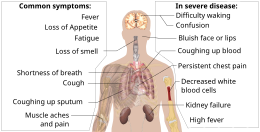Covid-19 Signs and symptoms
Symptoms of COVID-19 are variable, ranging from mild symptoms to severe illness.Common symptoms include headache, loss of smell (anosmia) and taste (ageusia), nasal congestion and runny nose, cough, muscle pain, sore throat, fever, diarrhea, and breathing difficulties. People with the same infection may have different symptoms, and their symptoms may change over time. Three common clusters of symptoms have been identified: one respiratory symptom cluster with cough, sputum, shortness of breath, and fever; a musculoskeletal symptom cluster with muscle and joint pain, headache, and fatigue; a cluster of digestive symptoms with abdominal pain, vomiting, and diarrhea. In people without prior ear, nose, and throat disorders, loss of taste combined with loss of smell is associated with COVID-19 and is reported in as many as 88% of cases.
Of people who show symptoms, 81% develop only mild to moderate symptoms (up to mild pneumonia), while 14% develop severe symptoms (dyspnea, hypoxia, or more than 50% lung involvement on imaging) and 5% of patients suffer critical symptoms (respiratory failure, shock, or multiorgan dysfunction). At least a third of the people who are infected with the virus do not develop noticeable symptoms at any point in time. These asymptomatic carriers tend not to get tested and can spread the disease. Other infected people will develop symptoms later, called "pre-symptomatic", or have very mild symptoms and can also spread the virus.
As is common with infections, there is a delay between the moment a person first becomes infected and the appearance of the first symptoms. The median delay for COVID-19 is four to five days. Most symptomatic people experience symptoms within two to seven days after exposure, and almost all will experience at least one symptom within 12 days.

%2C_by_John_Trumbull.jpg/240px-Declaration_of_Independence_(1819)%2C_by_John_Trumbull.jpg)
No comments:
Post a Comment